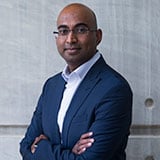Smart City Solutions for a Riskier World: a look into the impact of the COVID-19 pandemic and future city trends
As part of a recent feature in the Smart City Solutions for a Riskier World program, a few key participants were asked for their insights relating to the impact of the recent pandemic and future city trends. Here are some key highlights from Hatch’s Urban Solutions experts Andrew Caruso and Jarendra Reddy.
The impact of the pandemic
- In your opinion, what were the main challenges faced by cities during the pandemic? What were the key lessons learned and what will cities do differently going forward as a result?
In a recent study, we led with our clients–city governments, transit agencies, port and airport operators, private developers, and others–the vast majority reported significant challenges during the COVID pandemic to continue safe operations and maintain essential services amidst sharp declines in revenue. Yet, despite these challenges, our clients identified the pandemic as a catalyst for innovation, citing the adoption of digital processes and tools to boost productivity, accelerate organizational transformation, and enhance community and stakeholder engagement in planning initiatives and service provision. Necessity is the mother of invention, and our clients affirmed that the pandemic, like previous challenging periods in their history, could be an opportunity to reshape a stronger and more resilient future.
- The need for social distancing demonstrated the value of smart city solutions. What smart city solutions will cities prioritize as they emerge from the health crisis? How will they rethink their practices regarding technology, data, partnerships, and governance?
Technology undoubtedly helped cities respond to massive disruption from the pandemic, extending the reach, agility, and connection of workers amidst changing risks and tightening resources. We anticipate increased digital adoption in at least three areas:
- technologies that support remote operations and monitoring
- technologies that enhance the automation of processes, from procurement to service provision, especially where there is increased public health risk
- technologies that optimize resources and decision-making in real-time, for both providers and citizens (for example, real-time transit ridership and available capacity information)
Collecting and responding to real-time data will become increasingly important as traditional assumptions and use patterns evolve for the long term.
But there is also a softer side to the next digital wave. While smart solutions promise needed gains in productivity and resource efficiency, they must also be managed carefully to ensure that they enhance rather than undermine levels of trust, transparency, and credibility in the organizations they support. Technological adoption must not isolate communities and service providers from each other, and they guard against leaving behind those with varying levels of ability and access to engage digitally.
Read more about our work on the importance of digital infrastructure.
- The pandemic underlined the importance of using the UN’s SDGs as a road map for urban development. Which social, environmental, and economic goals will cities prioritize as a result of their COVID-19 experience?
The COVID-19 public health crisis has demonstrated vulnerabilities and capacity constraints of health systems worldwide. SDGs related to enhancing public health and well-being will certainly be a focus in the coming decades. However, we think the COVID-19 experience has also revealed the importance of designing healthy communities–walkable neighborhoods with access to good water, sanitation, and digital infrastructure, transit that provides broader access and mobility, robust and diverse economic opportunities, and healthy environmental assets. These objectives reach across the SDGs, with a particular focus on Goal 11: Building Sustainable Cities and Communities.
- Why is our research on Smart City Solutions for a Riskier World critical for city leaders? What evidence-based analysis and research do cities need now to recover from the pandemic and build for the future?
The need to constantly probe for “blind spots” was critical even before the pandemic, in the face of increasing demographic, technological, economic, and climate changes. The recent health crisis has only deepened the need for robust, quantitative evidence to inform decision-making and rethink previous models. A broad shift to remote working, delivery services, telehealth, e-learning, and other modifications will change patterns of consumption and settlement for years to come. Smart City Solutions for a Riskier World will help decision-makers anticipate these transformations and consider how to leverage them for success and shared prosperity without introducing new vulnerabilities and dependencies.
Read more about our work on mapping COVID vulnerability across the UK.
Future trends
- What will cities look like over the next three to five years? How will city living, shopping, working, and mobility change? Will Main Street look different? How so?
The COVID-19 experience has reinforced the fundamental principles of healthy, resilient communities. The ability to access the necessities of daily life within one’s local context–food, education, economic opportunity, transit, safe space for exercise, and digital connection–has proven essential to surviving catastrophic risk events of all types. Our hope is that cities evolve to embrace these “smart development fundamentals” in order to build vibrant communities that not only survive but thrive.
In addition, shocks and stressors will persist; adaptability is the new normal. Buildings will need to increasingly flex to accommodate new uses. In the wake of rising eCommerce, we hope main streets find reawakening in their history of social and civic functions, potentially reinvigorated by rising levels of non-motorized transport adoption.
Read more about our thoughts on the role of public transport in COVID recovery.
- What techniques and tools will cities of the future use to achieve their sustainable goals? What role will smart technology, partnerships, and financing play in improving social, environmental, and economic conditions?
Smart solutions will enable transformations in both demand and supply. Real-time feedback could help consumers understand the impacts of consumption patterns and make individual decisions that optimize their use of scarce resources. Likewise, providers can leverage more robust data to assess future requirements and pinpoint opportunities to improve products and services, leading to more efficient and less impactful consumption and production patterns. Life cycle costing and triple-bottom-line assessments have become important tools that we use with clients to evaluate the social, economic, and environmental impacts of decisions, and ultimately, communicate these impacts to stakeholders to build consensus and alignment toward progress.
While data-driven solutions promise more thoughtful, optimized answers, governance models must evolve in-step with the data revolution. Notions of privacy and ownership of data will be challenged as it increasingly becomes a new digital currency.
- How will cities use a range of partnerships to achieve their future goals? How will they leverage partnerships with companies, government agencies, other cities, start-ups, universities, and other entities to make things happen?
The current state of the airline industry, delinquency across commercial and residential real estate markets, and the crash of the tourism and hospitality sector are top-of-mind examples that demonstrate an upending of traditional relationships and business models. “Partnering” in this context implies a proactive restructuring of relationships across each element of the value chain to fundamentally preserve the future viability of key markets in our economy.
Moreover, the public health pandemic underscored the interconnectedness of our global society, motivating a type of “deep innovation” achievable only through a commitment to partnering. Current efforts toward a vaccine are exemplars of a commitment to collaboration that crosses national borders, scientific disciplines, and business models. Everyone has skin in this game.
Our hope is that cities emerge from this crisis with the same vision–the courage to reimagine existing relationships and structures between stakeholders and the focused ambition to generate opportunities for shared value and prosperity. Much like a vaccine trial, reinventing our cities will be iterative. It will require quantitative analysis and qualitative reflection. We must talk about failures as much as successes, shift away from celebrating individual successes to collective prosperity, and leverage and invent new technology at every step.

Andrew Caruso
Director, Strategy and Delivery, Urban Solutions
As an architect and international development professional, Andrew works at the intersection of urbanization, economics, and development within the world’s emerging cities. In addition to practicing architecture, he has led global research and strategy projects for private firms, NGOs, and foreign governments in rapid urbanization, resilience, and security, sustainable growth, and development economics.

Jarendra Reddy
Regional Director, Urban Solutions
Jarendra focuses on solving the most difficult problems facing cities within the context of rapid urbanization, climate change, technology disruption, and socio-economic changes. A combination of a diverse background, significant experience in complex multidisciplinary projects, and a proven track record in helping expert teams unleash their full potential enables Jarendra to challenge conventional thinking and deliver high-impact results for clients.